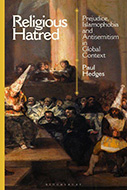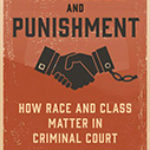Religious Hatred: Prejudice, Islamophobia and Antisemitism in Global Context

Author: Paul Hedges, London
Publisher: Bloomsbury Academic, 2021. 312 pages
Reviewer: Thomas Sealy ǀ November 2021
Islamophobia and antisemitism have been at the forefront of recent public and scholarly debates. Writing this review from the UK, in the last few years both the governing Conservative party and main opposition Labour party have been embroiled in controversies over Islamophobia, for the former, and antisemitism for the latter, under its former leadership. The relationship between the two terms and what they seek to capture has also been the subject of increased scholarly engagement in recent years; it has been the subject of a recent double special issue in Patterns of Prejudice (edited by Jansen and Meer, 2020) and an edited book collection by Renton and Gidley (2017), as well as of numerous articles from different country perspectives in recent years.
To this growing body of comparative work, Hedges’s contribution is welcome in a few respects. There is, firstly, something quite human about it. It is also interdisciplinary and global in its analysis and scope, features which stand out and, I think, set it apart in important ways. More about each, and also a few critical points, will be said as the following outlines how the book approaches its study.
The book is divided into four sections and each section has an ‘interlude’. The interludes are short chapters that enable Hedges to focus further on an important side issue without artificially shoehorning them into the text; but without which the text might seem less complete. In this, I think they are successful. The sections themselves follow a standard and entirely sensible progression. The first, Why do we hate? sets out Hedges’s theoretical and conceptual approach; I say theoretical, but Hedges terms what he is doing as ‘untheorizing.’ The focus of the second is historical, before the third turns to contemporary trends of prejudice in Western contexts, and the fourth section looks to other world regions, namely the Middle East and South and Southeast Asia. In this way the book is clearly set out and accessible to the reader to read cover to cover, or to pick out particular chapters.
In the first section, Hedges introduces and elucidates the bass notes of his interdisciplinary theoretical approach. This is where one of the key words in the title comes in, prejudice, and for which Hedges draws on positions from social and evolutionary psychology perspectives. This is also where the human aspect of the contribution comes in. Such psychology bass notes might, and often are, eschewed or treated with great caution by sociologists, but they are effective here in helping displace some binaries that can all too often occur; and not least in a period when there is so much talk about political and social fracture and polarization, this is welcome. Hedges highlights, for example, that “[w]e do not live in a binary world of prejudiced people and non-prejudiced people – or those who are racist/anti-racist…”, pointing out that we all have and show prejudice, it is not ‘unnatural’ or ‘pathological,’ and there is no getting away from it. He then goes on in subsequent chapters to bring this starting point to more sociological accounts of prejudice. As such, there are lessons for us all in the way Hedges approaches his study.
The initial section also sets the tone for Hedges’s approach of ‘untheorizing,’ which he outlines in the introduction as a “an attempt to get away from any overarching grand explanation” (p.4) and “supposing an ongoing essence” (p.5). Perhaps ‘retheorizing’ would be more accurate than ‘untheorizing,’ however. For one, the first section then goes on, quite precisely, to theorize: how else are we supposed to understand statements such as, “[t]he argument of this book is that antisemitism and Islamophobia are best understood as types of prejudice. No more, no less” (p.43) if not as a form of theorizing? Quibbling over this terminology is not really the point though. It seems clear from the book that there are both benefits and drawbacks to this approach.
The author’s approach certainly gains something. He traces interconnected points of cross over and influence, as well as of difference between contexts and times in relation to Islamophobia and antisemitism, and in ways which ensure the reader is kept thinking. This is a real strength of the book. Hedges shows the significance of contextual factors for understanding — for example, in relation to the Madrid bombings, initially linked to ETA by the government and media. He also shows this in relation to international links, such as those between the Nazis and Arab nationalists in the 1930s in their aims, and in responding in different contexts to try and achieve those aims. There is much to learn from this kind of more global perspective. His study is also global in another sense, including chapters on western contexts (especially Section 3) and on South and Southeast Asia and the Middle East (especially section 4), and he is able to effectively draw out contextual similarities as well as differences by so doing.
Equally importantly though, is to ask what we lose or miss by untheorising. For example, in seeking to explain the Holocaust (the question Hedges asks himself in Interlude 2 is ‘Why did the Holocaust happen?’) there is notable lack of significant historical detail in pursuit of the line of prejudice. We learn nothing about the fall out of the First World War, the Treaty of Versailles, or the Great Depression, for instance. The ‘system that allowed it’ is more straightforwardly prejudice; and we also get a quote from Bonhoeffer (p.103) which rather oversimplifies the great theologian’s (admittedly debated) thought, role and legacy. This is to say that despite the richness of the historical contexts and cross overs that Hedges draws through, there is a certain danger of flattening the historical picture when prejudice is its own grand explanation.
The flattening can also be conceptual. Hedges’s analytical thrust based on prejudice says little about the issue of structural, systemic or institutionalized discrimination, whether racism, antisemitism, Islamophobia or some other form. The fact that Hedges does discuss this in the second half of the book, but that it remains outside the analytical scope of untheorising is notable; the earlier ‘(un)theory’ chapters do not discuss it in these terms and it thus lacks some theoretical substance. I think also that the question of whether antisemitism and Islamophobia are really the same remains pertinent and not resolved by being untheorized. The status of the Holocaust for antisemitism, the experience of the Jews in the longue durée, and in the 20th century, are distinct enough to take conceptual difference seriously. The term Islamophobia took hold, in Britain at least – and Hedges himself refers to this (p.126), to identify a particular form of discrimination, and this is lost by reducing it to simple prejudice.
In relation to this last point, there are two further points about untheorizing that bear some comment. The first is the consistency in its application. It appears at first that one ‘grand explanation’ that is to be interrogated by untheorizing is ‘race,’ and Hedges does in fact bring a great deal more nuance to these discussions. The reliance on the language of ‘race’ in much of sociology has been criticized elsewhere as perhaps representing an instance of ‘conceptual inflation’ (Miles and Brown, 2003), and it at first appears that Hedges’s untheorizing approach is consistent with this. But ‘race’ still appears in its ‘grand explanation’ form — discrimination against religion becomes about ‘race’ (p.135). This is a common enough position in sociology but does not seem to follow untheorising. A reason this is important bears on Hedges’s Epilogue, in which he discusses interfaith dialogue. There’s much to agree with here, and of course interfaith studies form Hedges’s main body of scholarship. It is also a general strength of the book that Hedges treats religion, and theology, as meaningful categories both in fueling as well as overcoming the prejudices he talks about, and ones he is able to include effectively, critically and compassionately. What this suggests in general is that there is something about religion and faith that needs to be taken on its own terms, not divorced from issues of ‘race,’ but not reduced to them either. The aspect of the book where religion is reduced to issues of ‘race,’ therefore, seems slightly out of kilter when perhaps some further questions about its distinctiveness, and therefore distinctive responses, might be asked.
To conclude this review, it is worth restating that I believe the book to be of great worth. Rereading it for review has forced me to think harder about the things discussed above as well as others. I have learned a lot from it, and will undoubtedly return to it. In this sense, the critical points above are not meant to detract from the book; they represent rather an engagement with it. This is not least because the issue Hedges is grappling with, and the scope with which he does it, are complex, and his attempt in this book suffers no more than any other in this regard. Overall, the book offers rich reward for taking the time to read it and think about it.
References:
Jansen, Yolande and Meer, Nasar (2020) Genealogies of ‘Jews’ and ‘Muslims’: Social Imaginaries in the Race–Religion Nexus. A special issue. Patterns of Prejudice, 54(1-2).
Miles, Robert and Brown, Malcolm (2003 [1989]) Racism 2nd Edition, London: Routledge.
Renton, James and Gidley, Ben (2017) Antisemitism and Islamophobia in Europe: A Shared Story, Basingstoke: Palgrave.
Dr Thomas Sealy is a Research Associate at the Centre for the Study of Ethnicity and Citizenship in the School of Sociology, Politics and International Studies, University of Bristol.


